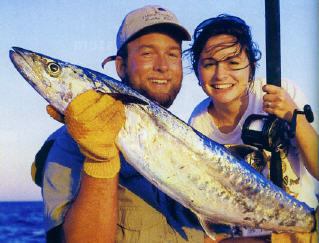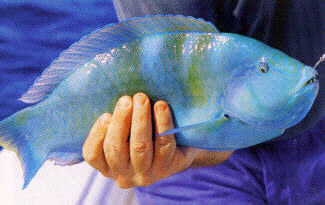June 01, 2001
By Jeff Weakley
Anglers explore unusual features in the South Florida seafloor.

Migratory kingfish sometimes linger in dredge holes, the sandy depressions left offshore in the wake of beach renourishment projects. |
A wave of ballyhoo crested in our chumslick and rolled quickly toward the stern. What seemed like hundreds of the slender fish jumped clear of the water, glittering and splashing like sudden rain.
“Somebody's home,” I remarked to my fishing companions, thinking the as yet unseen predator was probably a rogue kingfish or barracuda. That somebody identified itself
by charging the boat and at the last second flaring an indigo sail before turning away—a major surprise for three fishermen fooling around with groupers and mackerel on light tackle in 40 feet of water.
One of our rods had a fat, freelined pilchard swimming in the vicinity of the action, but the sailfish was evidently interested only in ballyhoo.
To me it seemed appropriate to find a Gulf Stream denizen like a sailfish wandering this close to shore. For the area we were fishing, a so-called dredge hole, was itself a puzzle of contradictions.
Dredge holes are byproducts of beach renourishment, a practice that would stupefy anyone unfamiliar with our state's legacy of manipulating the landscape for human convenience. For anglers, huge pits in the seafloor can mean good fishing, but they are also fertile ground for environmental concerns.
Officials refer to the holes as “borrow areas,” which is ironic because nothing is returned. The holes represent sources of fine-grained, light-colored sand that can be pumped up and hauled to the beaches to replace sand lost through erosion. The operation resembles a colossal Shop Vac at work: A specialized vessel called a hopper dredge sucks up sand and deposits it in the hold, typically 10,000 cubic yards per load. The vessel motors inshore and regurgitates the sand for bulldozers to spread along the beach.
What's left offshore resembles an artificial reef in reverse, a crater with hard structure around the perimeter. Baitfish and gamefish alike take up residence in and around the holes. Predators that hunt these areas include kingfish, sharks, cobia and, yes, even sailfish. Some of the steepest, most attractive holes were dug more than 10 years ago by hydraulic “cutter head” dredges that took sharp bites out of the bottom. The newer hopper dredges seem to leave a lighter footprint.
The holes are fishy in more than one sense of the word. Coral reef advocates have objected to the latest round of sand-dredging projects slated for three counties—Broward, Palm Beach and Indian River. They have concerns that dredging might harm reefs through sedimentation or direct physical damage, as in a 1988 case in which a dredge operator plowed two acres of natural coral off Dade County. Officials counter by pointing out modern dredge work involves high-tech navigational equipment and continuous monitoring. Moreover, buffer zones can be established between borrow areas and natural reefs, based on sophisticated mapping techniques. Which led me to a very interesting discovery.
While doing a little 'Net fishing on my office computer, I uncovered coastal survey data from the state Department of Environmental Protection showing borrow areas in Dade, Broward and Palm Beach counties, along with depth contours and hard bottom areas. I grew more excited with each mouse click, recalling a January 1997 article in which we detailed untapped fishing opportunities in holes as big as a football field and as deep as a 3-story building. Writer Bob Michals had included a starter list of GPS numbers—a few of which tuned me into some great winter kingfish action off Miami. First spot I went to, a drop from about 60 to 80 feet, my depthfinder screen nearly blacked out marking fish. Using 8-pound spinning tackle, I caught schoolie kings on a 1/2-ounce bucktail tipped with a ballyhoo strip one right after the other. Bottom baits fished in the same area produced small groupers, numerous sharks and some alarming cutoffs.
I'd been wanting to learn more about these areas, and with data from the state it suddenly seemed so simple. I could drop a cursor on productive-looking spots and record the latitude and longitude numbers for future trips. My results, if not always spectacular, have been thought-provoking.
The dredge holes off Miami, I learned, are pinched between the parallel north-south natural reeflines, and hence indicate transitional structure—always attractive to some fish or another. These areas have proven worthy of exploration, particularly on days when fishing is slow elsewhere. My own typical fishing trip begins well offshore of the holes, in 100 to 300 feet of water where I drift live baits for sails, dolphin and other bluewater species. If that doesn't pan out, I often move inshore to work the holes or nearby reefs for mixed-bag action.
On the day we saw the sailfish, Capt. Dave Kostyo and Mark Schindell and I were anchored on the edge of one of the inshore holes off Miami Beach. The mackerel had been running, and Kostyo expected we would tangle with some big Spanish and possibly kings, and certainly a mixed-bag of bottom fish. The fishfinder screen revealed scraggly marks indicating live bottom—probably sea fans and some corals. A few blips higher in the water column were likely made by fish. We started by dropping a block of frozen chum in a mesh bag and hanging it near the stern. Into the accompanying stream of oil and fish bits I drifted a live shrimp with a tiny splitshot and promptly hooked a red grouper just shy of the 20-inch minimum, typical of the hard-fished Miami area. The next grouper was another inch shorter, and the next, and the next, but plenty fun on 6-pound spinning tackle.
Over a half hour we caught and released numerous “bottom critters”—charterspeak for shorts or undesirables—including Schindell's parrotfish that somehow ran down a live pilchard. We—me, actually—also broke off two probable kingfish that intercepted shrimp on panfish-size tackle.
Moving to the second line of dredge holes, to one of my numbers which bottoms out at 90 feet, we managed only one small amberjack, though Kostyo acknowledged the potential for the area to attract kings during the spring and fall migration.
“When you hear the kings or mackerel are running, the dredge holes are the place to be,” he noted.
In general, it seems the best approach to fishing the dredge holes is to treat them not as defined targets but rather as territory for you to put to work your angling skills and equipment. A good fishfinder is critical, allowing you to survey the area before committing to anchor. Drifting or slow-trolling live baits is another way to check to see if anyone's home.

Not a targeted species, a parrotfish may be an indicator that hard bottom is nearby. |
Groupers—those keeper-size speci-mens that remain off South Florida—may be more likely to hole up along the hard edges and caps of the nearby reefs. Ditto for snappers, of which there is still a pretty decent population of mangroves and muttons in the area. Grunts of sometimes shocking size will eagerly bite cutbait anchored to the bottom. Kings and AJs may roam the basins, but again they are migratory, and not always dependable.
Mystery fish run the gamut. Our 1997 feature noted that African pompano had taken to roaming dredge holes off Jupiter, in Palm Beach County—followed in some cases by gigantic bull and tiger sharks.
According to Regional Editor Eden White, a series of once-productive dredge holes off Delray Beach, also in Palm Beach County, have mostly filled in, but “we still catch a lot of bait down there in summer, in 20 to 40 feet of water.”
Fort Lauderdale guide Ron Mallet indicates that Broward anglers, while blessed with an abundance of wrecks and artificial reefs, don't tap into dredge holes. “I've never heard of a dredge hole,” he said. However, Steve Higgins, Broward County beach erosion administrator, mentioned a few relic borrow areas off Hollywood Beach and Pompano Beach created by older, hydraulic dredges capable of boring sharp holes in the seafloor. And what of new dredge holes created by the latest round of beach renourishment? “The new hopper dredges leave smoother, cleaner areas that likely won't be as interesting,” Higgins said.
Miami-Dade County certainly has sizable dredge holes—they are so deep, in fact, that the county has acknowledged the need to locate outside sources for future sand needs. Imagine importing sand from The Bahamas. Don't laugh; it's an option.
As for other counties, one can only guess at what fishy new dredge holes might open up in the future. One thing is for certain, and that is as long as we build homes and hotels on a foundation of sand, we'll continue to rely on borrowed sand—and on borrowed time. For despite the goals of developers and politicians, Nature has her own designs for many Florida beaches. Waves and currents, accompanied by rising ocean levels, will demand that we add more and more sand.
And so, just as bass fishermen have profited from the water-draining canals of the Everglades, so their saltwater counterparts can reap the rewards, however unintended, of beach renourishment.
FS

